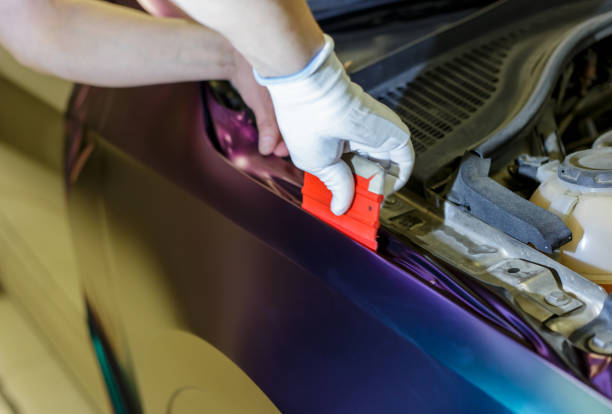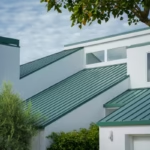Hydrophobic PPFs have become the go-to technology in the constantly developing field of automotive care to protect the appearance and resilience of car exteriors. These advanced films are from the top 10 ppf brands that provide protection from the environment and are easy to maintain since they are water-resistant. This article discusses the working and efficiency of hydrophobic PPFs and why the manufacturers of paint protection film are shifting towards this technology.
Hydrophobic properties
Modern PPFs are hydrophobic in nature, which means that when water is applied on the surface, it forms droplets that roll off the surface instead of spreading on it. This is done by the use of chemical coatings that change the surface tension of the film to the desired level. Hydrophobic PPF has its surface covered with fluoropolymers or silicones, which are compounds with low surface energy. This implies that water which has a high surface tension does not wet the film but forms droplets and rolls off. This property not only maintains the car clean but also minimizes the chances of water spots which are formed by mineral deposits when water dries up. Also, this hydrophobicity is useful in minimizing the corrosion rate of the outer surface of the vehicle since water and other contaminants lead to oxidation and other chemical reactions that degrade the paint and metal of the vehicle. In addition, the limited contact with water and other elements also helps to minimize the wear and tear that is likely to cause a car to deteriorate quickly.
Hydrophobic PPFs
The first benefit of hydrophobic PPFs is that they offer superior protection to the coated surfaces. These films prevent contaminants from sticking to the surface of the vehicle since they are water and dirt repellent, thus protecting the vehicle from damage from acidic pollutants and road grime. Also, hydrophobic surfaces do not require frequent washing and therefore, less time is spent in cleaning. Cars with hydrophobic PPF can be easily washed with water only, and this means that there is no need to use aggressive chemicals and abrasive brushes that can damage the coating in the long run. The hydrophobic properties also greatly minimize the amount of time and money that is spent on the maintenance of vehicles, thus making hydrophobic PPFs a cost-efficient solution to long-term car care. Furthermore, these films can assist in preserving the appearance of the vehicle for purposes of reselling and the owner’s satisfaction. The extra barrier offered by hydrophobic PPFs also assists in protecting the car from adverse weather conditions, as well as preventing the formation of ice and snow, which can be rather damaging to the car’s surface.
The Use of Nanotechnology
Hydrophobic PPFs are greatly benefited by nanotechnology in terms of improving their efficiency. Since the paint protection film manufacturers work at the molecular level, they can design the surfaces in such a way that they will only allow the liquids to behave in a certain way. For example, the nanostructures on the surface of the film can enhance the hydrophobicity of the film by raising the angle of the water droplet. This technology not only increases the water-repellent quality of the film but also the oil repellency, stain repellency, and dust repellency, which makes it a perfect protective layer for keeping the vehicle’s exterior looking as good as new. The use of nanotechnology in the production of PPFs makes them more efficient while at the same time being thinner and lighter, enhancing the overall experience of the users without having to sacrifice on protection.
Comparison and Care
When analyzing a PPF, it is necessary to focus on the top 10 ppf brands to identify the range of technologies used and the comparison of the brands. XPEL, 3M, and SunTek are some of the most popular brands because of their advancement in hydrophobic PPF technology. These brands dedicate a lot of resources to research and development to improve on the strength and efficiency of the films. Every brand has its own recipe and strategy on how they produce the hydrophobic properties of the product, some of them are aiming for the hardness of the coating while others are aiming for the slipperiness of the finish to improve the hydrophobicity. Understanding the strengths of each brand will enable the consumer to make the right choice depending on the situation and the environment.
Hydrophobic PPFs are best applied by professional painters, and this should be done by certified painters. Correct application guarantees that the film lays flat and does not have any air pockets or creases, which would compromise its ability to shield and repel water. Hydrophobic PPFs are easy to maintain but there are certain practices that need to be followed to ensure that the hydrophobicity is maintained. Cleaning is advised to be done with warm water and gentle soap, but not more than once a week, and the products used should be of a neutral pH. Do not use rough materials or chemicals that may scratch the surface of the hydrophobic layer. If well maintained, a hydrophobic PPF can last for several years and therefore is a worthy investment in the long-term protection of your car.
Conclusion
Non-stick PPFs are a major improvement in vehicle protection innovation, as they are both extremely hard-wearing and chemically advanced to provide the best shield against the external environment. Thus, by selecting a hydrophobic PPF from the list of the top 10 ppf brands, car owners can not only maintain the exterior look of their vehicles but also minimize the frequency of maintenance. With the advancement of paint protection film manufacturers, the effectiveness and versatility of hydrophobic PPFs are set to increase further, thus solidifying its role as an important part of today’s car care. The right hydrophobic PPF will change the way you protect your car, give you the peace of mind, keep the car’s value and looks intact throughout its life, and improve your driving experience with little effort and time. This technology is a good plan for those who want to increase the durability and appearance of their car and keep it in good condition despite the conditions it has to face.







